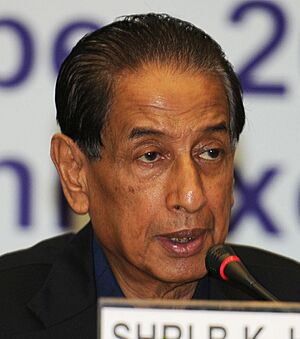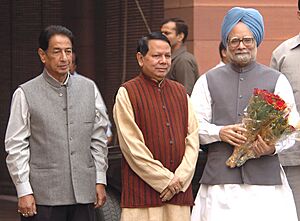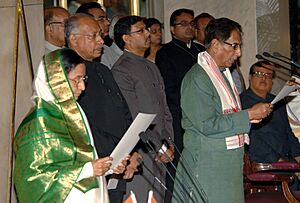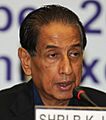Bijoy Krishna Handique facts for kids
Quick facts for kids
Bijoy Krishna Handique
|
|
|---|---|

Handique in 2010
|
|
| Minister of State for Defence & Parliamentary Affairs, Mines & Chemicals and Fertilizers | |
| In office 2004–2009 |
|
| Succeeded by | Dinsha Patel |
| Constituency | Jorhat |
| Minister of Mines, Minister of Development of North Eastern Region | |
| In office May 2009 – 18 January 2011 (Minister of Mines) July 2011 (Minister of DoNER) |
|
| Member of Parliament, Lok Sabha | |
| In office 1991 – 15 May 2014 |
|
| Preceded by | Parag Chaliha |
| Succeeded by | Kamakhya Prasad Tasa |
| Constituency | Jorhat |
| Member of Parliament, Rajya Sabha | |
| In office 1980–185 |
|
| Member of Assam Legislative Assembly | |
| In office 1972–1976 |
|
| Preceded by | J. Saikia |
| Succeeded by | Dulal Baruah |
| Constituency | Jorhat |
| Personal details | |
| Born | 1 December 1934 |
| Died | 26 July 2015 (aged 80) Jorhat, Assam, India |
| Political party | Indian National Congress |
| Spouse | Swarup Rani Borgohain |
| Children | 3 |
| Parent |
|
Bijoy Krishna Handique (born December 1, 1934 – died July 26, 2015) was an important Indian politician. He served as a Member of Parliament (MP) for the Jorhat area in Assam, India. He was part of the Indian National Congress (INC) political party.
Handique was the only son of Krishna Kanta Handique, a famous scholar. He represented Jorhat for six terms in the Lok Sabha, which is one of India's main parliamentary houses. He was also a member of the Rajya Sabha (the other main house) and the Assam Legislative Assembly, which is the state parliament.
Contents
Life Story of Bijoy Handique
Early Years and Schooling
Bijoy Handique studied English literature at Presidency College, Calcutta (now Kolkata). He earned his Master's degree in English from the University of Calcutta.
When he was younger, he went to Jorhat Govt. Boys' H.S and M.P. School. In Class VII, he joined the local Students' Congress. This was during India's fight for freedom. He helped other students campaign for the Congress party before the 1945 Assam elections. He also organized groups to talk about freedom. His father wanted him to become a scholar, but Bijoy was drawn to politics.
He officially became a member of the Youth Congress in 1961.
Starting a School in 1962
In the early 1960s, Handique noticed that there were no English-speaking schools in the large Upper Assam area. Because of this, he decided to start the Hemlata Handiqui Memorial Institute (HHMI) in 1962. It became the first English-medium school in Upper Assam. The school encouraged students to learn many different subjects, including music and Shakespeare.
Starting the school wasn't easy, even though his family bought the land. A few months after the school opened, the Indo-China war broke out in 1962. This caused a lot of fear in Jorhat, and many teachers and students left the town. Handique helped the Red Cross with their training and organization efforts. He even donated his mother's jewelry to help with the war.
The school closed for a month because of the war fears. In 2012, the school celebrated its 50th anniversary. Handique wrote a song for the event, which a former student set to music.
Working in Parliament
Bijoy Handique served in both houses of India's Parliament: the Rajya Sabha and the Lok Sabha.
Time in Rajya Sabha (1980-1985)
As a member of the Rajya Sabha, Handique was part of several important committees. He worked on committees related to education, sports, and the welfare of specific communities.
Time in Lok Sabha (1991-2004)
Later, as a Lok Sabha member, he continued to serve on various committees. These included committees on industry, food, official language, and foreign affairs. He also chaired the Railway Convention Committee.
Views on the Armed Forces Special Powers Act (AFSPA)
Handique often spoke about the Armed Forces (Special Powers) Act (AFSPA). This law gives special powers to the Indian Army in certain areas. He believed that while the army was there to protect citizens, the law could sometimes cause problems for ordinary people caught in difficult situations. He felt it was important to consider the impact on everyone.
Becoming a Minister (2004-2014)
Bijoy Handique became a minister in the Indian government.
Minister of State (2004-2009)
He served as the Union Minister of State for Chemicals & Fertilizers from 2006 to 2009. Before that, he was the Minister of State for Parliamentary Affairs and Defence.

During his time as a minister, Handique often gave talks to new government officers about how Parliament works. He also took part in many important debates in Parliament. These debates covered various topics, from issues in Assam like floods and railway lines to national laws on wildlife protection and health policy.
Cabinet Minister (2009-2014)
In 2009, Handique was promoted to a Union Cabinet Minister. He was in charge of two important areas: Mines and the Development of the North Eastern Region (DoNER).

Minister of Mines
As Minister of Mines, Handique worked to change India's mining rules. He suggested that 26% of the profits from mining operations should go to the local people who were directly affected by the mining. He believed this would help the communities living in mining areas, especially tribal groups, and prevent problems.
He also resisted pressure to sell off government shares in profitable mining companies like Coal India Ltd. He argued that it was better for the government to keep these companies. Handique also tried to stop private companies from taking too much control of mining profits through joint ventures.
He worked to address the problem of mining that was not allowed by law. He started investigations that helped bring attention to these issues. He also suggested a special tax on extra profits from iron ore exports when prices were very high. This tax would help raise money for people affected by mining projects.
Minister of Development of the North Eastern Region
As Minister of Development of the North Eastern Region, Handique made many important changes. He focused on improving connectivity, helping young people, and boosting industries in the region. He was known for his friendly approach and deep understanding of the North Eastern States. His main goal was to help integrate the region more fully with the rest of India.
After Being a Cabinet Minister
After leaving his cabinet roles, Handique became the chairman of a parliamentary committee that looked after the welfare of other backward classes. He was also a member of the Indian National Congress's Central Election Committee, which chooses party candidates for elections.
Personal Life
Bijoy Handique married Swarup Rani Borgohain in 1965. They had three daughters and two grandchildren. In his later years, he enjoyed writing poetry occasionally. He was also very interested in wildlife and protecting the environment.
Death and Funeral
Bijoy Handique passed away on July 26, 2015, at the age of 80. He had been admitted to Jorhat Medical College due to heart and breathing problems. He died from a heart attack.
Many political leaders and public figures shared their sadness and paid tribute to him. Sonia Gandhi, a prominent political leader, said he was a valuable member of past governments. The Assam government announced that he would be cremated with full state honors. Government offices and schools in the district closed early to show respect.
On July 27, Handique's body was taken to the Hemalata Handique Memorial Institute School and the Jorhat District Congress Committee office. He was cremated with full state honors at the Tarajan cremation ground. His daughter lit the funeral pyre, and Assam police personnel gave a gun salute. Many people, including political leaders and local residents, were present to say goodbye.
Awards and Recognition
In 2006, Bijoy Handique received the Venu Menon National Animal Award for Leadership in Conservation. He was given this award for his important work in protecting rare birds.
Books Written
Bijoy Handique's speeches and discussions as a Member of Parliament over 35 years were collected into three books:
- A Life in Parliament: Volume 1 (Rajya Sabha 1980-1986)
- A Life in Parliament: Volume II (Lok Sabha 1991-2004)
- A Life in Parliament: Volume III (Lok Sabha and Rajya Sabha 2004-2014)
These three books are nearly 1,000 pages long and cover many topics related to Assam, the North East, and India as a whole.
Images for kids


